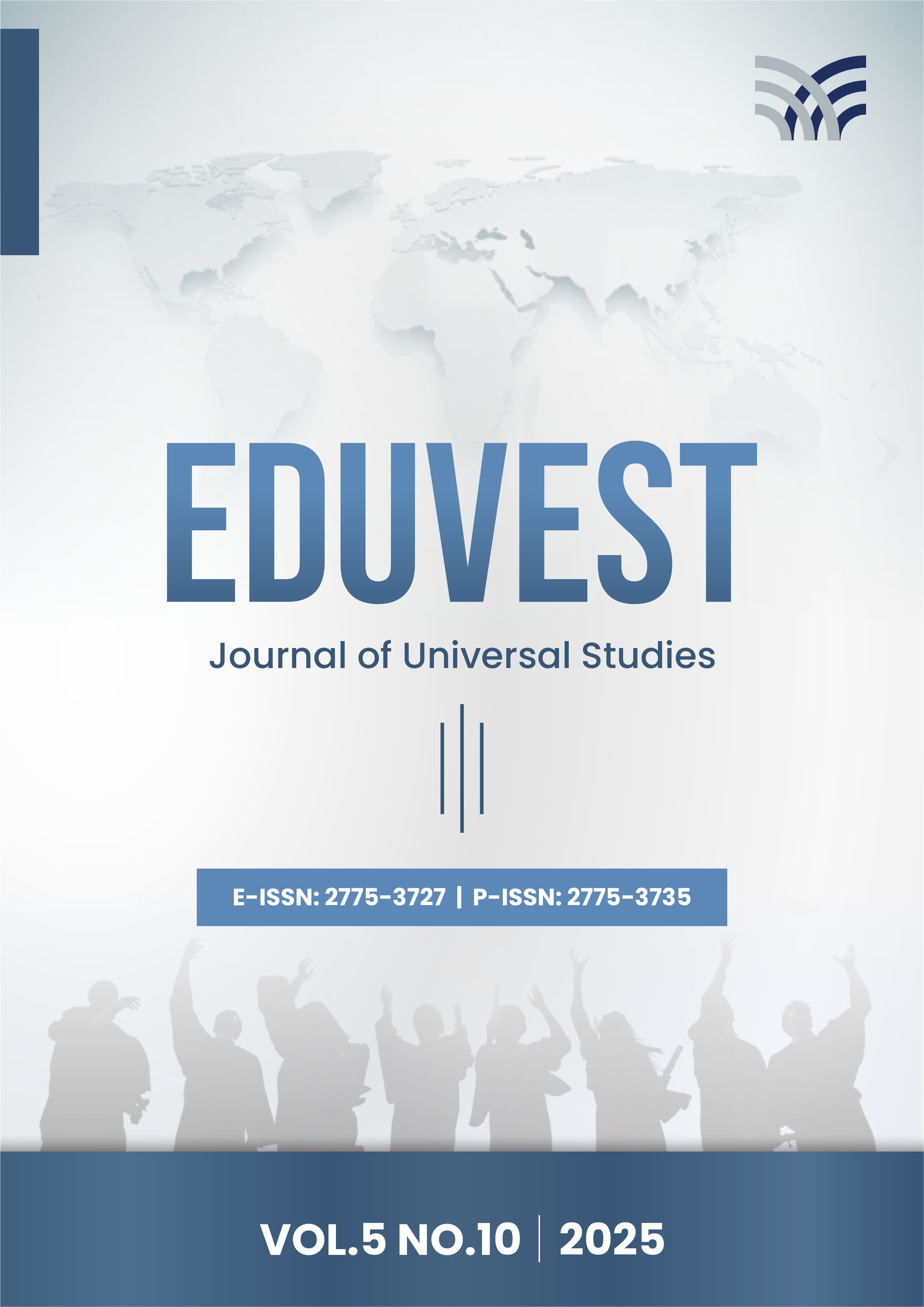Strategy Development Augmented Reality: Integrasi Concept Stimuli Organism Respon, Open Innovation, and Organizational Performance
DOI:
https://doi.org/10.59188/eduvest.v5i10.51274Keywords:
Augmented Reality, interactivity, stimuli, open-innovation, performance-organization, Fuzzy-AHP, SOR-modelAbstract
The development of digital technology has encouraged the adoption of Augmented Reality (AR) as a strategic innovation in various industries, but its application in Indonesia remains limited due to low awareness and a lack of an integrated innovation strategy. This research aims to develop a strategy to strengthen AR technology through the integration of the Stimuli-Organism-Response (SOR) model, the concept of Open Innovation (OI), and Organizational Performance (OP), with a case study on PT. X in the city of Bandung. A mixed methods approach was applied, combining qualitative and quantitative analysis using the Fuzzy Analytical Hierarchy Process (F-AHP) method to determine the priority of the strategy, as well as Partial Least Squares Structural Equation Modeling (PLS-SEM) to test the relationships between variables. The results showed that stimuli in the form of interactivity, augmentation, and AR aesthetics had a significant influence on internal organizational factors (organisms) and subsequently affected user behavioral responses, including reuse intentions. Meanwhile, open innovation plays an important role in strengthening organizational competitiveness through external collaboration, with inbound innovation being the most dominant factor. The research also resulted in three main strategies: improving interactive features and user experience, developing high-quality visual content, and strengthening collaborative networks through open innovation. The integration of SOR, OI, and OP models has proven effective in shaping a holistic, data-driven AR development strategy. The conclusion states that this approach can increase the adoption of digital technology and make a real contribution to organizational performance and digital economic growth in Indonesia.
References
Athaide, G. A., Jeon, J., Raj, S. P., Sivakumar, K., & Xiong, G. (2025). Marketing innovations and digital technologies: A systematic review, proposed framework, and future research agenda. Journal of Product Innovation Management, 42(1), 144–165.
Aviandy, M., Fajarwati, A. A. S., Alkatiri, Z., Yulianto, K., & Setiawan, H. (2024). Power dynamics in the arts sponsorship: Activities in Bandung and Yogyakarta during COVID-19. Humaniora, 15(1), 11–20.
Baranskaitė, E., & Labanauskaitė, D. (2020). The concept of innovation in the approach to novelty, value creating, interaction processes and social progress. Regional Formation & Development Studies, 31(2).
Carayannis, E. G., Samara, E. T., & Bakouros, Y. L. (2015). Innovation and entrepreneurship. Theory, Policy and Practice, 218(10.1007), 973–978.
Castelló-Sirvent, F., Meneses-Eraso, C., Alonso-Gómez, J., & Peris-Ortiz, M. (2022). Three decades of fuzzy AHP: A bibliometric analysis. Axioms, 11(10). https://doi.org/10.3390/axioms11100525
Djulaini, D. A., & Jayadi, R. (2023). The impact of factors that cause issues for non-ICT background workers in ICT jobs on their job satisfaction. Journal of Theoretical and Applied Information Technology, 101(6).
Hlee, S., Park, J., Park, H., Koo, C., & Chang, Y. (2023). Understanding customer's meaningful engagement with AI-powered service robots. Information Technology and People, 36(3), 1020–1047. https://doi.org/10.1108/ITP-10-2020-0740
Kim, M. J., Lee, C. K., & Jung, T. (2020). Exploring consumer behavior in virtual reality tourism using an extended stimulus-organism-response model. Journal of Travel Research, 59(1), 69–89. https://doi.org/10.1177/0047287518818915
Kogabayev, T., & Maziliauskas, A. (2017). The definition and classification of innovation. Holistica Journal of Business and Public Administration, 8(1), 59–72.
Oke, A. E., & Arowoiya, V. A. (2022). Critical barriers to augmented reality technology adoption in developing countries: A case study of Nigeria. Journal of Engineering, Design and Technology, 20(5), 1320–1333.
Pessot, E., Zangiacomi, A., & Sacco, M. (2025). Exploring SMEs innovation paths with augmented and virtual reality technologies. European Journal of Innovation Management, 28(3), 1181–1201.
Plotkina, D., Dinsmore, J., & Racat, M. (2022). Improving service brand personality with augmented reality marketing. Journal of Services Marketing, 36(6), 781–799.
Raghavan, A., Demircioglu, M. A., & Taeihagh, A. (2021). Public health innovation through cloud adoption: A comparative analysis of drivers and barriers in Japan, South Korea, and Singapore. International Journal of Environmental Research and Public Health, 18(1), 334.
Santi, G. M., Ceruti, A., Liverani, A., & Osti, F. (2021). Augmented reality in industry 4.0 and future innovation programs. Technologies, 9(2), 33.
Santos, L. L., Borini, F. M., & Oliveira Júnior, M. M. (2020). In search of the frugal innovation strategy. Review of International Business and Strategy, 30(3), 295–318. https://doi.org/10.1108/RIBS-10-2019-0142
Surtiari, G., Dalimunthe, S. A., Reksa, A. F. A., Pelupessy, D., Prasojo, A. P. S., Jibiki, Y., & Arikawa, T. (2024). Making virtual reality (VR)/augmented reality (AR) possible to strengthen disaster risk reduction among communities at risk of tsunami. International Journal of Disaster Management, 6(3), 291–312.
Ungerman, O., Dedkova, J., & Gurinova, K. (2018). The impact of marketing innovation on the competitiveness of enterprises in the context of industry 4.0. Journal of Competitiveness, 10(2), 132.
Wang, C., Chen, M., Wang, Q., & Fang, Y. (2023). The research of value network reconstruction and business model innovation driven by entrepreneurial orientation. International Entrepreneurship and Management Journal, 19(1), 127–150. https://doi.org/10.1007/s11365-023-00869-y
Wang, M., & Ji, H. (2022). Research on a risk control model based on selective ensemble algorithm of hierarchical clustering and simulated annealing. Procedia Computer Science, 199, 164–171. https://doi.org/10.1016/j.procs.2022.04.023
Downloads
Published
How to Cite
Issue
Section
License
Copyright (c) 2025 Mochamad Aldi Alisodikin, Endang Chumaidiyah, Iphov Kumala Sriwana

This work is licensed under a Creative Commons Attribution-ShareAlike 4.0 International License.











